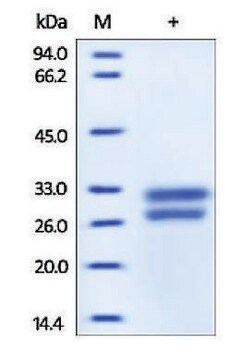H4652
HMG-1 Peptide
≥90% (SDS-PAGE), lyophilized powder, Histidine-tagged, human recombinant, expressed in E. coli
Sinónimos:
Amphoterin, HMGB1, High-Mobility-Group protein
About This Item
Productos recomendados
product name
HMG-1 human, lyophilized powder, ≥90% (SDS-PAGE), Histidine-tagged, recombinant, expressed in E. coli
recombinant
expressed in E. coli
Quality Level
assay
≥90% (SDS-PAGE)
form
lyophilized powder
mol wt
25 kDa
UniProt accession no.
shipped in
dry ice
storage temp.
−20°C
SMILES string
COC(=O)CCCCCCCCCCCCCCO
Gene Information
human ... HMGB1(3146)
General description
Application
- to prepare a standard curve for measuring HMG1 using ELISA (enzyme-linked immunosorbent assay) test
- to study the apoptotic ratios of Lewis cells in presence of exogenous HMG-1
- to study the changes in Th (T helper)-17 cell expansion in the presence of HMG-1 under in vitro conditions
- for the migration assay of GM7373 cells
Biochem/physiol Actions
Physical form
Analysis Note
signalword
Danger
hcodes
Hazard Classifications
Aquatic Acute 1 - Aquatic Chronic 2 - Eye Dam. 1
Storage Class
11 - Combustible Solids
wgk_germany
WGK 3
flash_point_f
Not applicable
flash_point_c
Not applicable
ppe
dust mask type N95 (US), Eyeshields, Gloves
Certificados de análisis (COA)
Busque Certificados de análisis (COA) introduciendo el número de lote del producto. Los números de lote se encuentran en la etiqueta del producto después de las palabras «Lot» o «Batch»
¿Ya tiene este producto?
Encuentre la documentación para los productos que ha comprado recientemente en la Biblioteca de documentos.
Nuestro equipo de científicos tiene experiencia en todas las áreas de investigación: Ciencias de la vida, Ciencia de los materiales, Síntesis química, Cromatografía, Analítica y muchas otras.
Póngase en contacto con el Servicio técnico





